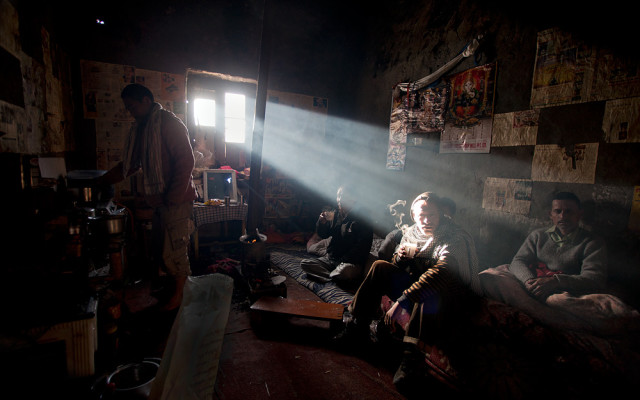Bridges had fallen and the roads were cut off. A long line of waited for many hours hoping for things to get better. Buses were cancelled and they had no clear answers to when the services will resume. “It depends on the weather, sir,” was the fence-sitting answer from the person manning the phone at the bus company, who neither had any real-time information nor had powers to provide decisive answers.
Himachal Pradesh was seeing heavy rains in the past few days. As it happens every year, landslides had crippled the road infrastructure and there was a cloud of uncertainty over what happens next. Unpredictable as the weather here is, things might magically settle back to normal next morning. Or it could very well turn worse if another line of dark clouds made their way towards the mountains.
My local contact constantly kept me updated on all the information he was able to procure. He had someone or the other in every part of Himachal giving him updates. Yet, nothing seemed certain. I turned to Twitter, looking for all the latest information that one could ask for. I had become like a journalist with a undying fetish for breaking news, scouring for every information that I could get, so that I can make informed decision on our next move.

Chandratal. This is where we were headed before the weather gods made us change plans.
The road from Delhi to Manali was affected by incessant rains that had brought down a bridge at someplace 100km before Manali. Himachal Parivahan had cancelled the night’s bus, since the bus that had left the previous evening from Delhi had not reached Manali yet. Nor did the buses from Manali make it to Delhi. We were stranded in Delhi for a night and were struggling to know the current status, so that we know what to do on the next day. My logistics organizer insisted that we rent a car and just head out, as someone would be working at the bridge and everything would be fine by the time we make the ten hour journey to the point-of-problem.
It is not easy to convince myself that people actually live in these places. My GPS continuously recorded altitudes above 13,000 feet. We did not sight even one tree despite walking for hours together. The sun happily burned every inch of unprotected skin, peeling away flakes of epidermis. Oxygen levels were so low that climbing even a hundred feet felt like a day long arduous task. At times we climbed over 15,000 feet, where the thinning air laughed at our struggling bodies. Winter temperatures apparently fall twenty below zero or even lower. For the people of Spiti Valley, this was everyday life.
Before we started the long walk from Komic to Dhemul, Tenzin Lama, a monk at Komic monastery (altitude – 14,700 feet) said it takes about two hours. “We normally start after lunch,” he mentioned casually, “and walking slow and easy, we reach Dhemul (altitude – 14,200 feet)well before dark.” He was trying to assure us that there is absolutely no need to hurry, or worry about the walk. While he talked, he was making Maggi and tea for all of us – an early lunch before we begin the long walk.
We had an amazing variety of estimates on the time it takes to reach Dhemul. Tenzin’s was the shortest, and he made it appear like a child’s play. The man who suggested us to make this walk had estimated five to six hours. The guide who accompanied us — Thekpa — was more cautious. He was watching over us and had assessed our strengths better. He thought we will require about eight hours.
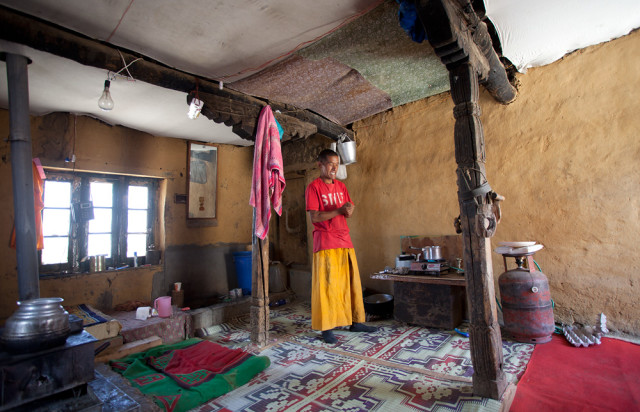
Lama Tenzin offered us tea and maggi before we embarked on the trek
It was eleven in the morning when we began conversations at Tenzing’s cozy little room at Komic Monastery. He was a cheerful chap who never seemed to stop talking, occasionally offering weird poses for our trigger happy group. When someone aimed the camera at him making tea, he would stand on one leg, other leg dangling in the air and his hands mimicking someone pouring tea from a kettle into a cup. The gang loved him instantly.
The good times lasted only as long as we were having Maggi with Tenzin. The struggle for oxygen began soon after we left Komic. On ascents, no matter how gentle it was, every step seemed like an attempt to carry a big ball of steel tied to the shoes. Descents were much bearable, but much of our way that day was a gradual climb. The views however, were something that justified the effort. Whenever we paused and looked back, Komic village appeared like a bunch of match boxes against a gigantic line of mountains that challenged the sky.
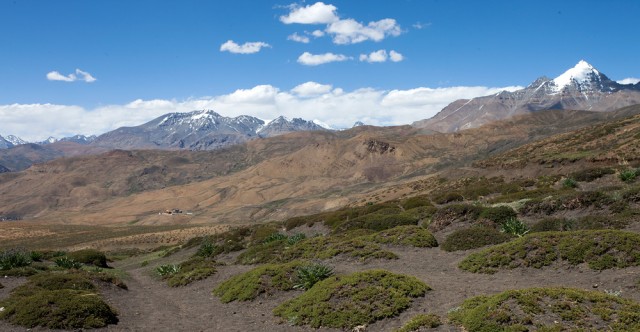
Komic was a small dot on the landscape. The snow-capped Chau Chau Kang Nilda Peak dominated the views.
With very little precipitation in the previous winter, many of the peaks far behind the village were unusually bare and brown. The tall Chau Chau Kang Nilda rose much higher than its neighbours and wore a shiny white that was worth the envy of its counterparts. On the opposite site, the mountains plunged steeply for more than two thousand feet into the valley of Spiti River, rising again to form another chain of snow-capped peaks. But most importantly, ahead lay a path that seemed to keep going upwards forever!
It must be about two hour’s of uphill journey before a short descent made a kind appearance. After the descent was a plateau-like area, full of a variety of thorny plants that had carpeted the earth. Thekpa, our guide, said that all those plants will begin flowering after the first rains in August and the earth turns purple with the efflorescence. The plants were so numerous and widespread in the plateau, it would be worthwhile coming here again to fill that scene in the eyes.
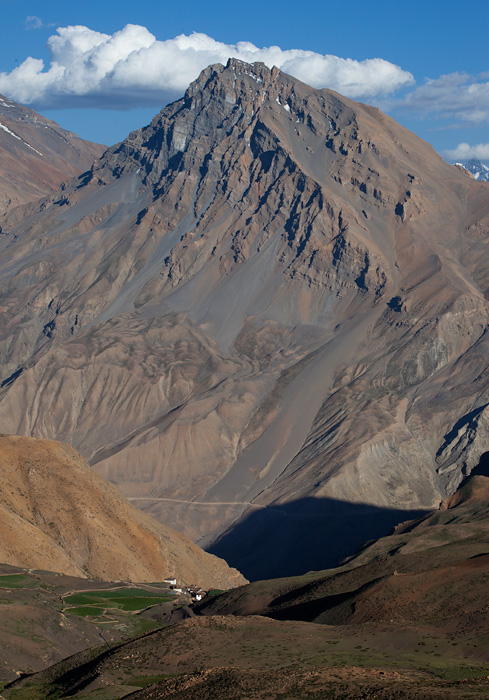
From the highest point of the trek, Dhemul Village appeared like a small spot trapped in the mountains.
After a short break and a short eat at the end of the plateau, it was time for a long and final ascent. It was nearly 5pm when we reached the highest point of the trek at 15,700 feet. Beyond the pass, we could see Dhemul village as a small spot trapped in the mountains. Now, it was a steep descent that we estimated to be a twenty minutes walk. The ever-cautious Thekpa suggested an hour. It turned out, he was right.
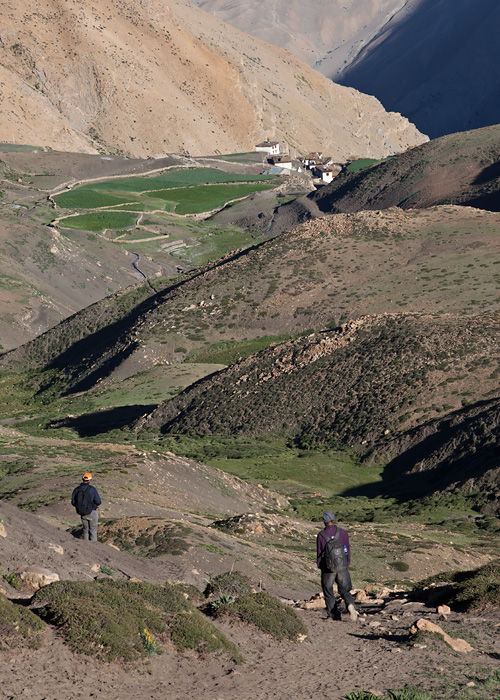
So near, yet so far. We thought it takes 20 minutes to get to the village. Our guide Thekpa suggested an hour. He was right!
We reached Dhemul at 6pm, a walk that took us a total of seven hours that included an hour of careless gallivanting off the path. Thekpa’s estimates turned out to be more reasonable than Tenzing’s.
Dhemul, much like Komic, was a village that appeared out of nowhere. It is amazing how people sustain in these villages, high up in the mountains and faraway from every other place. A hundred years ago when they weren’t touched by modernity, they lived an almost self-sustained life with the help of their flock of animals and subsistence farming. Sheep and yak provided them with milk, butter and meat while the barley fields gave them cereals. The fields are usually spread very close to the village and the villages are usually located next to a perennial stream that never dries up. Perhaps only salt and spices had to come from outside, may be from a long southern route via Kinnaur Valley. Their houses too, were built with locally available materials. The walls were of mud, while the roof was held in place with poles of willow that were grown all around the village. Every village in Spiti has a similar ecosystem, which looks like a verdant escape in the otherwise desert landscape.
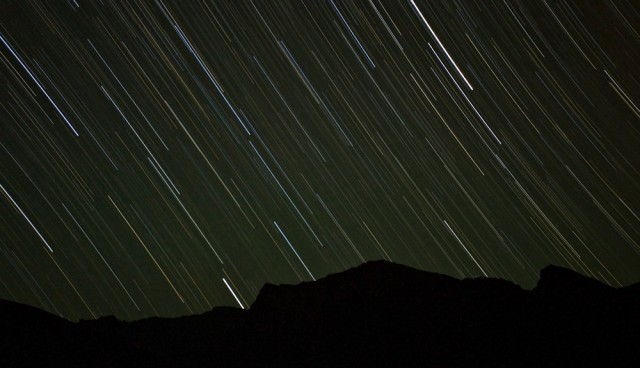
A starry night at Lalung Village
Today, many of these villages are connected by road. A road is perhaps the most important thing that changes the lives of people forever. People still rely a great deal on their yak, sheep and barley fields. But they now have access to comfortable clothing that comes from outside, get to sleep in more comfortable mattresses, cook with LPG, eat rice and wheat besides barley and buy vegetables that they would never have access to earlier. Electricity poles too have made their way to many villages. Power supply is limited and erratic and is often backed by solar panels, but more often than not, people can cook their dinner under a bulb watching television. A more recent phenomenon – direct to home television – has invaded the homes rapidly, thanks to the receivers given away by Prasar Bharati.
Despite all these modern comforts having arrived in Spiti, I still can’t stop wondering how people ever lived here. The extreme weathers and limited resources still governs their frugal and efficient lifestyle. In the last two decades, Spiti’s Villages have routinely broken several records, such as the highest village in the world with permanent habitation, highest village with motor roads, highest village with access to electricity, highest fuel pump in the world, highest village with a post office and so on. While we get to hear about some of these statistics at every turn, not every one of them may be necessarily true.
Perhaps these harsh conditions of living have made Spitians understand human sufferings better than anyone else, and be of assistance to everyone in need. At the village, after we had comfortably settled in, I realized that we did not know where our guide was staying. An attempt to look for Thekpa alerted the entire village and the news spread quickly to wherever Thekpa was, who came to meet us. The moment someone got to know, several villagers had gone looking out for him, taking up the task as a personal mission. Later that night, the kind lady of the house took out the best vegetables in the house (aubergines, at 14,000 feet) to make our dinner. The villagers took care of us like a bunch of old relatives who were visiting after a long time.
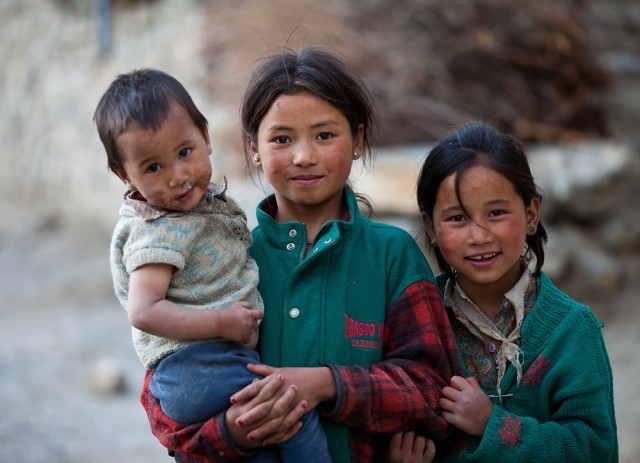
These girls posed for a picture at Lalung Village.
The next morning, we were scheduled to make another long walk – this time thankfully downhill all the way – to Lalung Village (altitude – 12,300 feet). But the news had arrived that the annual festival at the monastery in Ki Village is scheduled on the same day. We changed our plans and boarded a vehicle to Ki, spent the day at the festival and took the road to Lalung Village in the evening.
The festival deserves another complete post, but the images and a brief report is available here – images of festival at Ki Monastery.

